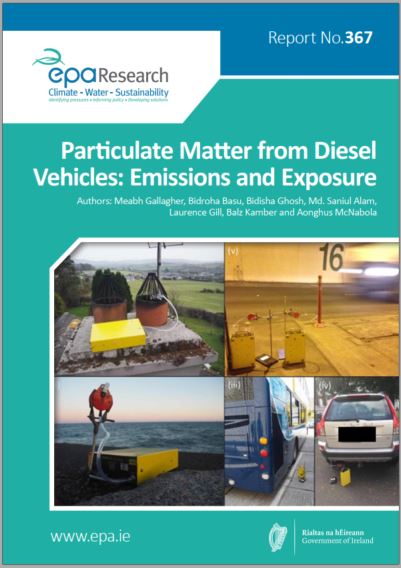Research 367: Particulate Matter from Diesel Vehicles: Emissions and Exposure
Authors: Meabh Gallagher, Bidroha Basu, Bidisha Ghosh, Md. Saniul Alam, Laurence Gill, BalzKamber and Aonghus McNabola
Summary: Research was conducted to assess the contribution of diesel vehicle emissions to the concentrations of PM2.5 in Dublin. The major source identified was solid fuel burning, contributing 46-50% of the total mass recorded. The 2nd largest contributor at a roadside site was diesel vehicle emissions (22%) followed closely by road dust (19%). The 2nd largest source at a suburban site was soil (20%) followed closely by sea spray (14%).

Project Highlights
Watch the project highlights video
Identifying Pressures
Clean air is considered a basic requirement of human health preservation and well-being. Epidemiological studies have shown that even low levels of air pollution in industrialised societies are linked to adverse health outcomes. The Environmental Protection Agency (EPA) reports that the most problematic pollutants in Ireland are particulate matter (PM, including PM < 2.5 μm in aerodynamic diameter – PM2.5 – and PM < 10 μm in aerodynamic diameter – PM10) and oxides of nitrogen (NOx). In Ireland in 2015 and 2016, more than 70% of new cars sold were diesel-fuelled cars, whereas the average in the European Union was 50%. Diesel vehicles are known to be a significant source of particulate air pollution, emitting more PM than other vehicle types. Owing to the recent growth in private diesel vehicles in Ireland since 2008, this vehicle category may represent a significant pressure on the quality of the urban environment in Ireland and requires investigation to quantify these potential impacts.
Informing Policy
A 2-year research project was conducted in Dublin to assess the contribution of diesel vehicle emissions to the concentrations of PM2.5 that the population is exposed to (2016–2018). PM2.5 was monitored for over 1 year at two locations in Dublin. Source apportionment sampling and analysis, and positive matrix factorisation (PMF) modelling were conducted to determine the major sources of PM2.5 in Dublin. The major source of PM2.5 identified at the two sites was solid fuel burning, contributing 46–50% of the total PM2.5 mass recorded. The second largest contributor at Site A (roadside location in the city centre) was diesel vehicle emissions (22%), followed closely by road dust (19%). Other sources made minor contributions at Site A (sea salt, soil and petrol vehicles were all < 4%). The second largest source at Site B (urban background location in a residential neighbourhood) was soil (20%) followed closely by sea spray (14%). Road dust and diesel exhaust emissions, 8% and 9% respectively, contributed significantly less at Site B. The resulting predicted number of deaths and disability-adjusted life years (DALYs) lost associated with diesel PM2.5 pollution are expected to be in the ranges of 46–93 deaths and 2.53–5.07 years, respectively.
Developing Solutions
The breakdown of the PM2.5 sources measured in Dublin using the PMF model revealed a contribution from diesel vehicles of 22% and 9% of ambient PM2.5 at Sites A and B. In comparison, emissions from petrol vehicles accounted for 3.2% and 1.4% at Sites A and B, respectively. Diesel vehicles were the second largest source of PM2.5 at the roadside location but only the fourth largest at the urban background location. Solid fuel combustion was the largest source of PM2.5 in both cases by a considerable margin. Road dust was also a significant source of PM2.5 and was shown to contain a number of toxic metals. Considering the major pressures on the environment at both study locations, a reduction in emissions from solid fuel stands to make the largest contribution to human health protection in Dublin at present. Reductions in diesel vehicle numbers (to address the contribution of road dust to PM2.5 emissions of 19% and of diesel exhaust to PM2.5 emissions of 22%) stand to make a comparable reduction in PM2.5 concentrations at roadside locations. However, mitigating measures must address travel demand as well as emission rate and fuel type in order to reduce both exhaust and non-exhaust emissions.
https://www.epa.ie/media/epa-2020/research/epa-funded-research/Twitter_367.jpg